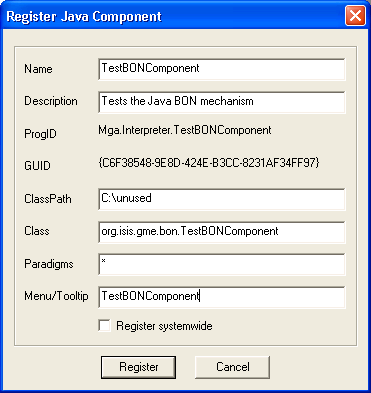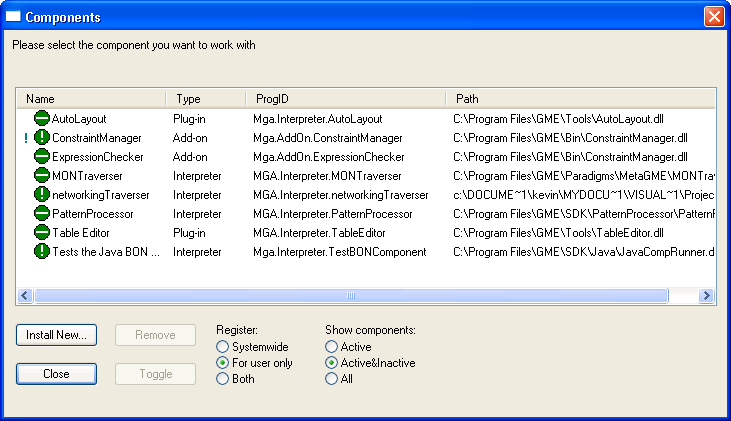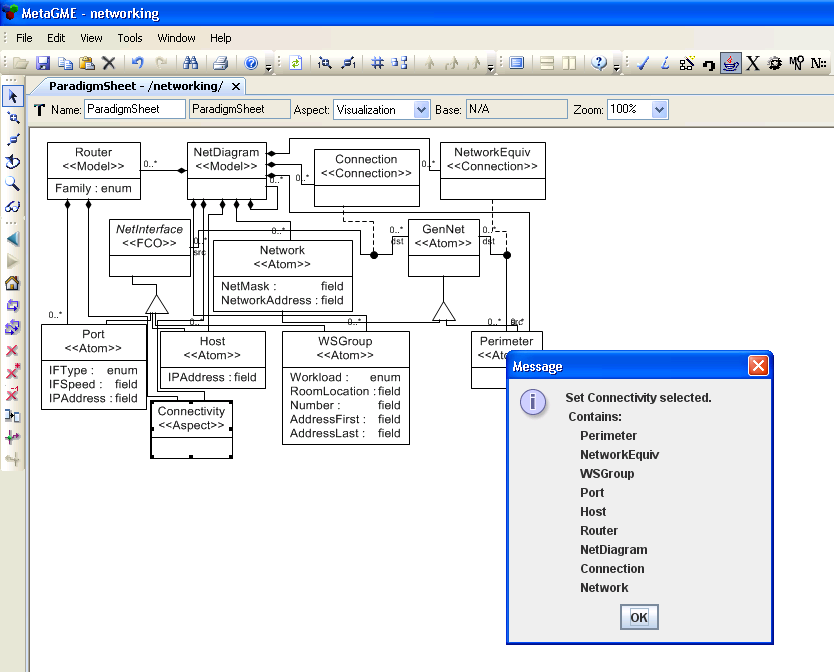
Fig 8.1 Registering a Java Component
Introduction to Lesson 8
8.1 Creating and Registering a Java component
8.2 Writing and Running the interpreter
The BON, Builder Object Network, was originally implemented in C++. However, some GME users may not be able to program in C++ or might not have Microsoft's Visual Studio to compile a BON interpreter. Also, a particular problem might be easier to solve in Java than in C++. For many reasons such as these, a Java COM interface to GME and Java version of the BON have been created.
This lesson discusses the process of building a Java based interpreter. The example interpreter will be domain independent. The paradigm used to test the interpreter will be that from Lesson 4. Our interpreter will simply display a message box showing set and reference information from the list of currently selected FCOs.
To use the Java interface to GME, one needs to have the latest version of GME installed which includes JAUT.dll and JavaCompRegister.exe in addition to having the latest JRE or JDK installed on their machine. The packages that will be used are:
First create a class that implements either the BONComponent or Component Interfaces in the bon package. Implementing BONComponent will give access to GME through the BON, whereas implementing Component will give access through a Java Raw COM implementation. There is a TestBONComponent.java and TestComponent.java included in the bon package as examples. This tutorial uses TestBONComponent. Now run JavaCompRegister.exe:

Notice that the ClassPath is the path to the package and the Class entry needs
the class name including the package it is contained in. After Registering the
Java Component, it will become available inside GME.

The class hierarchy for the Java BON replicates the hierarchy for the original C++ BON, with the exception that all classnames that are prefixed with a "C" now start with a "J". The Java BON also behaves like the original BON by creating Java Objects corresponding to the GME objects found within the project being interpreted. The function names have only been changed to reflect the Java convention of function names starting with lower case letters. The Java BON is instantiated through a class factory that will instantiate user created Custom classes. The example interpreter here will not utilize that functionality. Please see the Java interpreter included with the SF paradigm to see an example using the JBuilderFactory.
The example interpreter here implements the BONComponent Interface. Therefore the invokeEx() and registerCustomClasses() functions must be implemented. Because the Factory will not be used, the registerCustomClasses() functions can be left empty. The invokeEx() function will take the selected objects Collection, iterating through it, looking for Sets and References. It will build up a message string that will display the names and contents of sets, and the names and objects referred to by References. If the Reference is for a Model, it will find out what the ports are connected to in the Reference, and in the Model Referred to.
After writing the code (which can be found in the Java class org.isis.gme.TestBONComponent) Run GME, enable the component registered at the beginning of this chapter for a paradigm. Notice there is now a Java Coffee cup emblem on a button in the components list. The tooltip should read what was entered during the registration step. To run, select some objects and click on the Java cup:

So now you are able to interpret your GME projects using Java.
| << Previous Lesson | Complete List | Next Lesson >> |